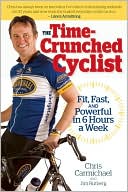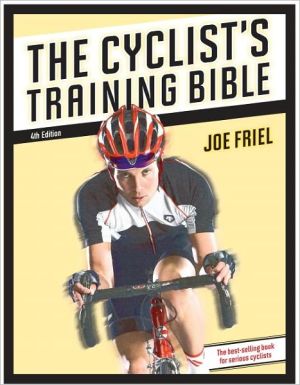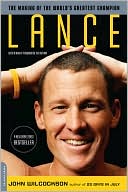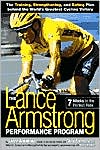The Complete Book of Road Cycling and Road Racing
Ride faster, fitter, smarter, & farther\ Every road rider has goals. Yours may be to begin racing, to become more competitive, or to win a specific tour. Not interested in racing? Perhaps you want to complete your first century ride, improve your overall fitness, or ride father and faster just for the sheer joy of flying on two wheels.\ No matter what your goals, The Complete Book of Road Cycling and Racing gives you all the information you need to become a better, more...
Search in google:
Ride faster, fitter, smarter, & fartherEvery road rider has goals. Yours may be to begin racing, to become more competitive, or to win a specific tour. Not interested in racing? Perhaps you want to complete your first century ride, improve your overall fitness, or ride father and faster just for the sheer joy of flying on two wheels.No matter what your goals, The Complete Book of Road Cycling and Racing gives you all the information you need to become a better, more performance-focused cyclist. Written by an accomplished racing coach, cyclist, and exercise physiologist, this book shows you how to:Fit the bike to your body for maximum efficiency and comfort Ride safely in a group Cope with any weather or altitude Maintain your bike Prepare for races of all types Master racing strategies and tactics Train efficiently and stay in peak condition year-round And much more
the complete book of road cycling & racing\ \ By WILL PEVELER \ McGraw-Hill\ Copyright © 2009 McGraw-Hill\ All right reserved.\ ISBN: 978-0-07-164341-2 \ \ \ Chapter One\ choosing a bike\ Copyright © 2009 by McGraw-Hill. Click here for terms of use.\ Locating a good bike shop with a helpful, knowledgeable staff is the first step in selecting your bike and equipment. The staff should encourage you to explain your cycling experience and goals in detail, and should ask many questions. They should have the capabilities to fit you properly on your new bike. If a shop can't or won't provide this level of service, find another shop within driving distance.\ Your relationship with the bike shop should be a two-way street. The shop provides valuable services at a fair rate, including objective purchasing advice, mechanical repairs, assistance with warranty issues, advice on riding and racing, and information about local clubs and events. Shops also provide a social atmosphere where cyclists meet and talk about riding. In return, you owe them your loyal business. Give it to them and they'll bend over backward to meet your needs, such as when you need a repair done ASAP.\ You may be able to save a few dollars purchasing equipment through online retailers, but they cannot maintain your bike. Of course, you must be guided by your personal economics, and if you have excellent mechanical skills, you may be able to get by largely on your own.\ HOW TO BUY\ Choosing a bike can be daunting. There are different frame types, materials, and geometries, and different component groups. Your choice will depend on your riding needs, the fit and feel of the bike, and how much you are willing to spend.\ Cost and Warranty\ A new bike that is appropriate for serious riding with an eye toward performance can cost anywhere from $600 to more than $6,000. You could purchase a $90 bike from a discount store, but I advise against it. Such mass-produced bikes are fine for riding short distances around the neighborhood but will not hold up on long rides. They have a heavy frame and low-end components and do not have sealed bearings. They do not perform well straight off the shelf or over the long haul and are subject to continuous mechanicals (mechanical breakdowns) that will quickly add up to more money than the bike is worth. Keep in mind that you will also need accessories, and they can add up. Go in with a set spending limit and stick to it.\ Price and weight are inversely related in bicycles. Making frames and other components light as well as strong involves more precise work and higher-quality materials. The old saying "you get what you pay for" applies, but you do not need to spend a fortune. It is cheaper to lose weight off your body than off the bike, and some bikes in the $600 to $1,400 range offer excellent quality.\ Many companies provide a lifetime frame warranty; others offer five- to twenty-five-year warranties. (Parts usually have a one-year warranty.) Warranties typically cover manufacturer defects but not damage due to crashes, although some companies offer a "crash replacement" warranty under which they will replace a crashed frame for much less than its retail cost. In my experience as a bike shop manager, all of the manufacturers were really good about honoring their warranties.\ New Versus Used\ As with cars, there are pros and cons to buying a used bike. The potential upside, of course, is that you can get more bike for your money. On the downside, you may be buying someone else's problems. Before buying a used bike, have it inspected to ensure that the components are in working order and the frame is not corroded, cracked, or otherwise damaged.\ At the high end of the price range, I recommend buying new so you're covered by warranty. Recently, a fatigue crack opened up in one of my high-end frames after four years of riding. The manufacturer replaced the frame with a new model that was better than the original.\ If you are in the market for a used bike, here are three good places to look:\ * Many bike shops sell used bikes they have acquired through trade or on consignment. They will ensure that the bike is in working order and may back it with a limited warranty.\ * Many clubs post classified ads on their websites or pass information by word of mouth.\ * Of all the places to buy used bikes on the Internet, eBay seems to have the widest selection and the safest means of purchasing. You will probably not be able to examine the bike before buying it, and you will need to know your frame size in the specific brand you are considering.\ Buying a Stock Bike Versus Building Your Own\ Most bikes are bought off the showroom floor, but some cyclists dream of buying a bare frame, choosing each component individually, and assembling the bike themselves or having a local shop do it for them. This occasionally makes sense for advanced riders who are familiar with various components and have particular preferences.\ For most riders, however, building your own bike is impractical. Bike manufacturers usually do an excellent job of specifying appropriate components for different types of bikes in different price ranges. Because they buy components in large quantities, they receive deep discounts. You would probably add $200 to $800 to the cost of a bike by purchasing the frame and identical components individually. My advice is to buy the stock bike, and have the shop swap out any individual components you want to change.\ THE BIKE FRAME\ The frame is the heart of the bike and the greatest single determinant of its quality and performance. Although every component can be replaced, if you replace the frame you've got a new bike. No amount of component replacement will make a good bike from a lousy frame (although it's possible to turn a good frame into a lousy bike with poor components).\ Frame Geometries\ Frame geometry deals with the length and angle of the tubes. It affects the bike's ride quality, steering quickness, and handling.\ Road Racing\ Racing bikes have a steep head-tube angle, usually between 73 and 74 degrees from the horizontal. This makes the steering responsive and maneuverable. To beginners, this feels "twitchy," but given time, most riders become accustomed to the feel. The seat-tube angle is also usually 73 to 74 degrees, placing the rider over the pedals, allowing for efficient transfer of energy, and promoting an aerodynamic position on the bike. These frames are also designed to be stable at high speeds and stiff in a sprint. A short wheelbase also lends itself to increased maneuverability.\ Touring\ Touring bikes are designed to be stable at slower speeds, to carry gear, and to provide greater comfort than race bikes. With a shallower head tube angle of 71 to 72 degrees, touring frames have slower, more stable steering than race bikes, which makes it possible to attach panniers and carry cargo. The seat tube angle is also 71 to 72 degrees, allowing for a more comfortable upright position. Touring bikes usually have a longer wheelbase than race bikes, which makes for slower steering but increased stability.\ Sport\ Sport bikes fall between racing and touring bikes. These frames are a little more comfortable than racing frames, have slightly relaxed handling, and promote a more upright position for riders for whom speed is not the sole criterion. The head tube and seat tube angles are 72 to 73 degrees. These bikes are a good choice for beginning riders and riders who are more concerned with comfort than speed but won't be doing extensive touring with heavy gear. Sport bikes usually have a longer wheelbase for stability.\ A friend bought a serious race bike with a head-tube angle of 73 degrees, a rake of 45 mm, and a short chain stay. It was a good bike, but he could not get comfortable on it. As a cyclist, his goal is participating in century rides, and he has no interest in racing.\ He soon sold the racer and bought a sport bike with a head-tube angle of 72 degrees, a rake of 49 mm, and a longer chain stay. The bike positions him in a more comfortable, upright posture that he can maintain for hours. It's not a better bike, but it's better suited to his needs.\ Time Trial\ Time-trial frames are designed to give an aerodynamic advantage to riders in races where they cannot draft. The seat-tube angle ranges from 73 to 78 degrees, with the steeper angles promoting the most aerodynamic posture.\ Steeper, however, isn't always better. Research has shown that cyclists adapt to and perform optimally in one particular position. So if you want to do time trials in addition to other events, choose a time-trial frame with a seat-tube angle similar to the one on the bike you normally ride.\ The Union Cycliste Internationale (UCI), the governing body of international bicycle racing, and the United States Cycling Federation (USCF) have strict guidelines for bike geometry. According to UCI rules, the nose of the saddle must be at least five centimeters behind the bottom-bracket spindle, effectively limiting the seat-tube angle to a maximum of about 76 degrees. The UCI also requires that frames be of the conventional double-diamond style, with a seat tube that connects to the bottom bracket.\ USA Triathlon (USAT), the governing body of triathlon and duathlon in the United States, has no such specifications. Many triathlon bikes have a seat-tube angle as steep as 78 degrees, and some companies have developed aerodynamic frames that do not have a seat tube that connects to the bottom bracket. Although these bikes are illegal in time trials, they are well accepted in triathlons. If you plan to compete in time trials and triathlons, make sure the bike is time-trial legal.\ Traditional Versus Compact Frames\ Compact frames are also known as sloping-tube geometries because the top tube slopes down to the rear. (On a traditional frame, it is horizontal.) The head-tube and seat-tube angles are similar in traditional and compact geometries, although compact frames have a slightly smaller rear triangle (formed by the chain stay, seat stay, and seat tube).\ Nearly half of professional cycling teams now ride compact geometry. The other half doesn't. So what's the story? Is one better than the other?\ In practice, the two geometries produce equivalent results. On both types of frame, you contact the bike at three points—the saddle, handlebars, and pedals—and you set up the bike the same way. With compact geometry you get a larger range of adjustment with the seat post. Some manufacturers have responded by producing only three or four frame sizes, which may leave a few riders to fall through the cracks, but most companies produce compact frames in the same range of eight or so sizes comparable to traditional-geometry bikes. (The effective top-tube length of a compact-geometry bike is measured horizontally, not along the tube, and is the same as on a traditional frame.)\ Some cyclists claim that the smaller rear triangle of a compact frame makes the bike stiffer, but manufacturers that carefully select good materials can engineer the desired degree of stiffness in either type of frame. It is also claimed that compact frames are lighter, but if you add in the extra weight of the longer seat post, there is no noticeable difference.\ Women-Specific Geometries\ Recently, companies such as Cannondale, Trek, and Specialized have introduced lines of road bikes designed specifically for women. Recognizing that men and women have different proportions, the companies changed frame geometry and components accordingly. A woman's torso tends to be shorter, so the top-tube length is shorter to make it easier to reach the handlebars. Whereas most road bikes have 700C wheels (see page 15), some of the smaller women's frames come with 650C wheels, for a shorter stand-over height. Handlebars have been narrowed for narrow shoulders and the diameter of the tube is thinner, and the shift levers are shorter for smaller hands.\ Not all women need women-specific geometry. Many taller women fit better on bikes with standard geometry, and some men and children fit better on "women's" bikes. The choice of geometry should be determined by your body, not your gender.\ Frame Materials\ Frames are usually made of steel, aluminum, titanium, or carbon fiber. A few companies build frames using combinations of materials. Each material has advantages and disadvantages, but there can be big differences in quality among frames built from the same material. A $150 steel frame, for example, is much heavier, has a poorer ride quality, and will not last as long as a $1,500 steel frame.\ Steel\ Modern steel frames are lighter and stronger than their predecessors. The steel lugs that used to hold the tubes together have been replaced with TIG-welded joints, and the walls of the tubes are of varying thickness to eliminate excess weight. Even the metallurgy of the steel itself has improved.\ Steel frames have a comfortable ride quality, but they flex during sprints and climbing. Thin-walled tubes have a tendency to dent easily, and steel is subject to rust. To help increase the life of your steel frame, coat the inside with a rust inhibitor on a regular basis. Finally, there is something to be said about the classic feel and look of a steel frame.\ Titanium\ The most expensive frame material, titanium provides a comfortable ride similar to that of steel, but it's much lighter. It has a longer fatigue life than steel and aluminum, but it tends to flex more than aluminum or carbon fiber during sprints. Titanium does not rust and does not need to be painted; nor does the inside need to be coated against rust.\ Aluminum\ Aluminum is stiffer and lighter than steel and is the least expensive choice for a lightweight bike of good quality. It's possible to buy a new aluminum-frame bike that weighs 22 to 23 pounds for $600 to $800. Steel-frame bikes in that weight range typically cost 30 to 50 percent more. Although most aluminum bikes cost less than those made of titanium, aluminum is lighter at the same price level. The downside of its stiffness is a rough ride, although this can be partially compensated for by a high-quality carbon fiber fork, seat post, and handlebars. Aluminum frames do not rust and have the shortest fatigue life of any frame material, with a life expectancy of five to ten years.\ Carbon Fiber\ Early versions of carbon fiber frames used carbon fiber tubing joined by aluminum lugs. Although these were not successful, recent advances have resulted in the lightest, strongest, and most comfortable frames available. Most frames built now use a nearly undetectable carbon fiber lug; others are made in a single piece in molds.\ Carbon fiber is the choice of many pro riders; it produces a comfortable ride that is stiff in a sprint. When you apply pressure to the pedals, the bike responds immediately; you can feel it accelerate smoothly and quickly.\ Carbon fiber has the longest fatigue life of any frame material. The downside is that carbon fiber frames are expensive.\ All frame materials have advantages and disadvantages. I ride a carbon frame, which I think is the most comfortable and responsive material. Other riders prefer steel, saying it allows them to feel the road better. You will need to ride bikes with each material to determine which you like best. Many bike shops have demo bikes that you can use to determine your preference.\ Butted Tubes\ Conventional metal tubing has a constant wall thickness and is known as plain- or straight-gauge tubing. In steel, aluminum, and titanium frames of higher quality, the inside diameter of the tubing wall varies along its length; the tubing walls are thicker at the ends, where additional strength is needed, and thinner in the middle to save weight. These are known as butted tubes. (As a composite material, carbon fiber lends itself to continuous variation in thickness and reinforcement.)\ Tube butting appears in three basic formats:\ * Single butted. The tube wall is thicker at one end and uniformly thinner throughout the rest of its length.\ * Double butted. The tube is the same thickness at both ends and uniformly thinner between them.\ * Triple butted. Both ends are thicker than the middle, but one end is thinner than the other. The middle is of uniform thickness.\ Butted tubing is mainly used in the seat tube, down tube, and top tube. The downside to butted tubing is that the middle of the tubes is more susceptible to denting and fatigue. It is also more expensive than plain-gauge tubing.\ Frame Aerodynamics\ Traditional frames have round tubing and are ideal for climbing or flat stages. Although they lack any aerodynamic advantage, they are much lighter than aero frames and generally more comfortable. When riding in a peloton (a tightly bunched group of cyclists), there is little need for an aerodynamic frame; weight when climbing is a greater concern.\ (Continues...)\ \ \ \ \ Excerpted from the complete book of road cycling & racing by WILL PEVELER Copyright © 2009 by McGraw-Hill. Excerpted by permission of McGraw-Hill. All rights reserved. No part of this excerpt may be reproduced or reprinted without permission in writing from the publisher.\ Excerpts are provided by Dial-A-Book Inc. solely for the personal use of visitors to this web site. \ \
Preface ixAcknowledgments xiIntroductionWhy Ride? xiiiBike and Gear xivRaces and Rides xivNoncompetitive Riding xvTraining and Nutrition xvHow to Get Involved xvThe bikeChoosing a bikeHow to Buy 2The Bike Frame 3Components and Groups 9Other Gear 18Cycle Computers 23Fitting the bike to your bodyPerformance Versus Comfort 25Frame Size 25Crank-Arm Length 26Cleat Position 27Saddle Adjustments 27Handlebar Adjustments 30Time-Trial Setup 31Recording Your Setup 33Bike maintenanceBasic Maintenance Principles 34Cleaning 36After Rain 37Maintenance Procedures 37Repairs on the Road 63Riding and racingRiding skillsPosture/Position 66Pedaling 68Braking 72Steering 73Cornering 74Climbing Hills 75Road Conditions 75Riding in Traffic 76Riding in a Group 77Weather and altitudeRiding in the Heat 80Riding in the Cold 83Riding at High Altitudes 86SafetyPreventing Accidents 89Health and Injury 91Races and ridesRacing 96Noncompetitive Riding 99Finding Events 100Registration 100Money 100Logistics 101Equipment Check 102Race Day 103Racing skills, strategy, and tacticsMaking Contact 105Pace Line 106Strategy 110Tactics 111Training and fitnessTraining programsDeveloping Your Own Training Program 120Monitoring Training 125Coaching 126Cycling physiologyThe Cardiorespiratory System 128Energy Systems 131Muscle Fibers 133VO[subscript 2] Max 134Anaerobic and Lactate Thresholds 136Training Adaptations 137Essential principles of trainingOverload 140Recovery 141Overtraining 141Specificity of Training 142Detraining 142Consistency 143Frequency 143Duration 143Flexibility 149Off-season trainingIndoor Training 154Cross Training 156Resistance Training 156Designing a Strength-Training Program 158Weight-Training Techniques 161NutritionNutrients 174Nutrition and Exercise 178Ergogenic aidsEthics and Legality 182Supplements 183Illegal Aids 187Your unique physiqueBody Composition Goals 190Weight Management 195Women 199Aging 202Youth 203Overweight and Obesity 204Diabetes 205Asthma 206Training log 207Resources 209Index 211








